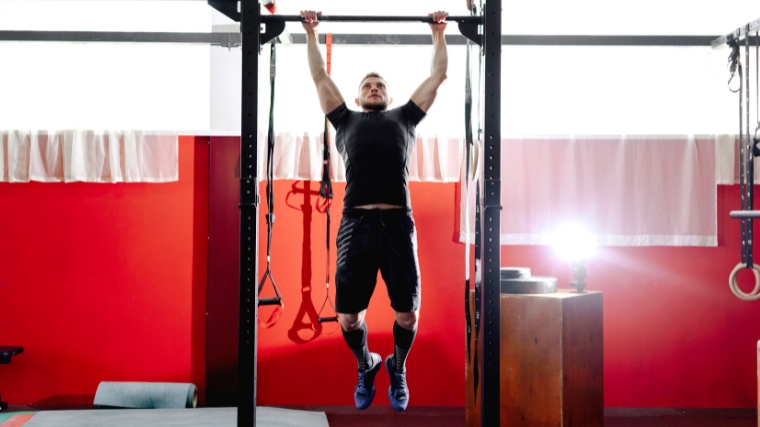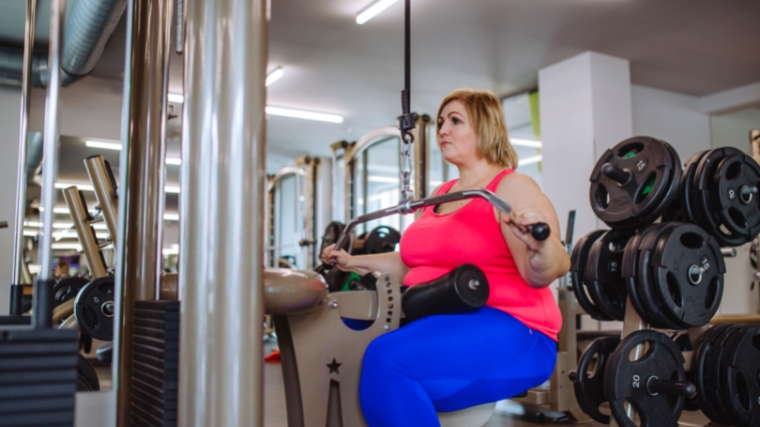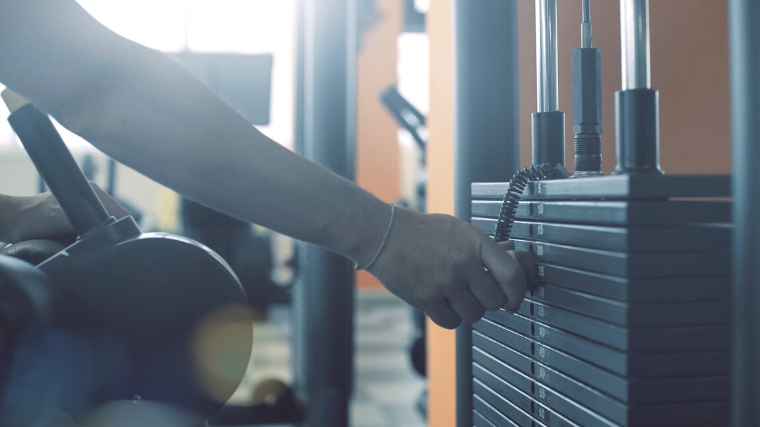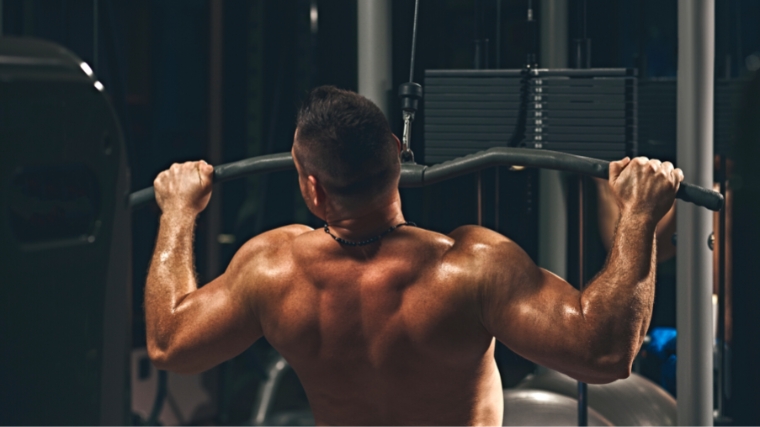Pull-ups are, basically, the universal back exercise. From high school gym class to professional gymnastics to the armed forces, pulling your body up to a fixed bar reigns supreme for developing upper back strength.
The lat pulldown station, by contrast, tends to be relegated as an accessory exercise or a stepping stone — something you do before you can nail your first pull-up.

While there may be a good bit of daylight between the two, don’t be too hasty to throw one out in favor of the other altogether. There’s a good chance that either the pull-up or the pulldown (or maybe even both) is exactly what you need in your workout routine. Here’s the scoop.
Differences Between the Lat Pulldown & Pull-Up
The pulldown and pull-up highlight just how much of a difference your choice of resistance can make. Working with a loaded pulley system, or your own body’s weight, can turn the same movement pattern on its head entirely.
Closed vs. Open-Chain
In human kinetics, most exercises are categorized as either open or closed-chain movements.
The pulldown — whether you use a cable or a plate-loaded machine — is an open-chain exercise. The distal segment of your body, meaning the point of contact furthest from your body (in this case, your hands), moves freely in space while your body remains still.

Conversely, pull-ups are closed-chain movements. Your hands fix to a non-moving object (in this case, the bar you’re hanging from), and you pull your body against the resistance of gravity. Closed-chain movements aren’t exactly synonymous with calisthenics, but they can indicate when you can expect to work with your own body as resistance.
Resistance Profile
The nature of the resistance applied to your body during each movement is what truly separates the pulldown from the pull-up.
Pulldowns are a standard resistance training movement; you’re working with a loadable implement that you can adjust in weight to match the strength of your lats, traps, and shoulders.
On the other hand, pull-ups are a calisthenics exercise. They work the exact same muscles (for the most part, more on that in a bit), but the challenge in the pull-up comes from having to move your physical self through space and against gravity. The heavier you are, the harder pull-ups will generally be.
Muscle Recruitment
Both exercises work your upper body in almost the exact same way. From the waist up, both the pulldown and pull-up should appear visually indistinguishable. The primary muscles at play are your lats, traps, scapular stabilizers, and biceps.

However, hanging freely in space during a pull-up adds an additional element to the mix — core stability. The musculature of your trunk and hips contract isometrically to hold your legs still while you pull yourself up to the bar.
Your legs will sit firmly fixed against a knee pad when you use the lat pulldown station. This affords you a surface to brace against, taking your lower body out of the equation altogether.
Loadability
Generally speaking, the most straightforward and effective way to make an exercise more difficult (and thus more productive) is to add some form of external resistance.
Loading the pulldown is as easy as adjusting the setting of the pin on the plate stack. The further down the stack you place the pin, the more weight you have to move.

Adding resistance to the pull-up is a bit trickier. While the exercise will be inherently more challenging if you’re on the heavier side, this represents more of a relative change. You can load your pull-ups by holding a small weight between your ankles or even wearing a weight belt, but these options are often cumbersome to set up and may be more trouble than they’re worth depending on your needs.
Further, adding even a small amount of weight to your pull-ups can induce a far greater challenge than performing pulldowns with the same increase in load. Such is the nature of many bodyweight exercises; they don’t have a linear strength curve.
Difficulty of Performance
Pull-ups aren’t generally considered an advanced bodyweight exercise, but they can be quite challenging, even for those with a good amount of gym experience. If you’re a larger athlete, poor grip strength, or aren’t comfortable with calisthenics, you may find it difficult to hang out more than two or three at a time at first.
On the other hand, the design of the pulldown station offers you a great deal of customization regarding resistance. You can adjust the pin to apply almost no extra load at all, or you can go ultra-heavy if you have strong lats already.
Similarities Between the Lat Pulldown & Pull-Up
The two movements boast plenty of physiological differences, sure, but they’re fundamentally similar movements; similar enough that you can replace the pulldown with the pull-up (or vice-versa).
Motor Pattern
If you think the pulldown and pull-up look quite samey, that’s because they are. Both exercises require you to perform, essentially, the same movement pattern.

[Read More: Our Favorite Forearm Workouts, + the Best Forearm Exercises]
You’ll find that both exercises demand that you depress and retract your shoulder blades while bending your arm at the elbow as well. In fact, if you were to view both exercises side-by-side, they should look completely indiscernible from the waist up.
Muscle Engagement
Both the pulldown and the pull-up are phenomenal compound (meaning more than one joint in motion) exercises for training your back. They each work nearly your entire upper back, and you can get some biceps stimulation as well.
Furthermore, you can adjust your execution — particularly your hand position and grip width — to bias certain muscles over others.
Accessibility
You can perform the pull-up and pulldown just about anywhere; this is especially true regarding pull-ups, since all you need is a sturdy bar to hang from. That said, just about every commercial gym out there will have at least one lat pulldown station. In fact, many cable fixtures also come with various pull-up handles as well.
Pull-ups gain some extra points for being home-gym-friendly, but both movements are extremely accessible and practical.
Lat Pulldown vs. Pull-Up Technique
Just because you can perform pulldowns with a good bit of weight doesn’t mean you can necessarily hop up onto the pull-up bar and bang out 10 crystal-clear reps. That said, the fundamental techniques of the two movements are more similar than they are different.
How to Do the Lat Pulldown
The default pulldown is performed by sitting into a low bench and pulling on a handle that is fixed to a cable pulley. There are a wide assortment of different handles and grip options, but you’ll generally perform pulldowns with a shoulder-width, double-overhand grip.
- Stand in front of the station and grip the handle with a moderate, overhand grip.
- Lower yourself into the seat. Your legs should brace up against the thigh pads as you sit down. The weight plates should come up off the stack and your arms should hang freely above your head.
- Lean back slightly and inhale into your belly.
- Pull the handle downward toward your collarbones. Keep your elbow and forearm in line with the direction you’re pulling.
- Pull until your shoulders are fully depressed and your arms are bent. Your elbows should remain underneath the bar the entire time.
Coach’s Tip: You can think about “putting your elbows into your back pockets” to really connect with your lats.
How to Do the Pull-Up
To get to work on your pull-up game, all you need is a fixed bar to hang from. The standard pull-up has a shoulder-width, overhand grip. Going wider or more narrow can dramatically alter the difficulty of the exercise.
- Suspend yourself from the bar by taking a small vertical hop or climbing up the rack and lowering yourself down.
- In the starting position, your arms and shoulders should hang loosely. Contract your core and tighten your legs to reduce any bodily swaying.
- Initiate the pull-up by squeezing your shoulder blades down and back and then pulling with your arms.
- Pull until the bar reaches around the height of your clavicles. Your head should fully clear the height of the bar.
Coach’s Tip: Try to prevent any swinging of your lower body, as the extra movement will make it much more difficult to perform sequential repetitions.
When to Do the Lat Pulldown or Pull-Up
Here’s the deal; pulldowns and pull-ups share some visual elements, but when it comes to programming, the case is fairly cut and dry.
Knowing which movement best suits your goals can save you time and frustration in the gym, and help you get after the back gains you want.
If You’re a Beginner
First of all, congratulations on getting started in the weight room. If you want to train your back effectively, the question is more of effort than of the implement you’re working with.
Still, the ability to perform a rock-solid pull-up is a fundamental athletic skill. When you’re getting started, it might be wise to aim for a solid set of 8-10 pull-ups before experimenting with other movements.

The back strength and bodily awareness you cultivate with pull-ups will carry over well to other exercises. Furthermore, pull-ups tend to drop off in difficulty once you develop into a well-trained athlete. Best to exploit their usefulness early on.
For Muscle Growth
Building muscle is all about applying tension to the tissue in question. You can accomplish this with pull-ups, sure, but the exercise demands you give some attention to things like balance, grip strength, or core control as well.
These factors detract from the primary goal of loading your upper back. As such, you should strive to take them out of the equation and use the pulldown instead. Pulldowns stabilize your lower body for you and allow you to conveniently work with just the right amount of weight to induce muscle growth.
For Total-Body Strength
You can build an impressive array of general fitness with a few high-quality exercises. The pull-up is one of your best options for strengthening your body from head to toe, since it requires you to mix upper body muscular strength with grip endurance and midline core control all at the same time.
When You’re Short on Time
Having hours to spend in the weight room every day is a luxury you may not enjoy at all times. Sometimes you need to get in there, go hard, and get out in a jiffy. If you’re on the fence between pull-ups and pulldowns when time is short, you can go for either.
You may need many, many sets of pulldowns to fatigue your back; two sets of weighed pull-ups to failure will absolutely torch you. However, pulldowns allow you to implement time-saving intensity techniques like drop sets. Which exercise you go for will really depend on what’s available at the moment. If there’s a line for the pulldown station, hit up some pull-ups instead.
Pull It Together
A strong back is a statement. It sends the message that you’re concerned with both form and function. Strong and muscular lats and traps look good in a shirt, sure, but developing those muscles will also help your posture and bolster your performance on many other weight room movements.
Whether you opt for pull-ups out of necessity or you want to dial in your back days with pulldowns, you’ll get the gains you want as long as you’re working hard.
Featured Image: Mirage_studio / Shutterstock